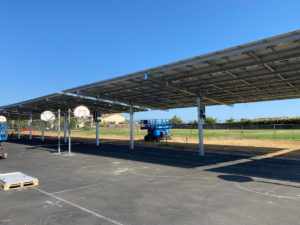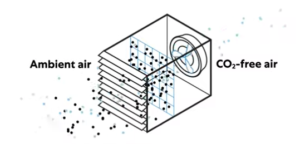In This Issue
- Flanigan’s EcoLogic: Climate Optimism
- Hybrid Sailing on the Ramblin’ Rose
- EcoMotion Joins California Clean Air Day Pledge
- Los Angeles Accelerates Climate Pledge
- U.S. Solar Futures Study
- Decarbonizing Shipping
- NETs: Direct Air Capture
- Amazon Shout-Out
- Carbon-Negative Cement

Flanigan’s Eco-Logic: Climate Optimism
Call me nuts. Sure, the eco-system is hugely taxed. In some ways it is clear that the sky is falling.
Devastation is its proof. The climate is screaming… more intensely, more frequently… with greater ferocity. The fires, the floods, hurricanes, and tornadic activity. I am fully aware of it all. And, I am optimistic. This is the time for action… and lots of it… and fast.
It wasn’t the way I wanted to spend lunch with Laurie. It was a glorious summer day in Burlington, Vermont. Bright sunshine; crystal clear air; billowing clouds. Terry and I made a special exception to our family-only East Coast trip to drop in on Laurie and and his wife Laura, the LaLa’s as they are known in their singing group! Laurie’s a childhood friend, our sailing captain, builder of my favorite guitar, energy efficiency expert, green builder extraordinaire… as close to family as it gets. He’s a great bud. But he’s down.
Too much climate reality. He stated clearly that he wanted me to give him some hope. We drove past old Burlington watering holes, the Sheik, the Chicken Bone. Please raise me up! Laurie wanted me to convince him that one can be optimistic in light of it all. Ugh… I wasn’t really jazzed about making a pitch to a skeptic that day. Hey, I’m on vacation! Just give me a turkey sandwich! No. All set for a heady lunch at “The Spot?” Nice shade, good food, lots of boating going on… great views out over Lake Champlain to the Adirondacks. But back to work as an eco-advocate!
We’ve got this. From a technical standpoint, we can indeed craft a sustainable, global society. And, we’ll craft a higher quality of life when we do so. It’s about living smart, like mixed zoning to allow for people to work close to their homes… obviating the need for cars and commuting and costly infrastructure and headaches that it requires and festers.
The pandemic has taught many of us how to live and work at home and to take on healthy habits. In our sustainable future, there will be more time for family and friends, less focus on the materialism that has clearly been part of our elevated footprint.
The breadth and creativity of the sustainability movement is fantastic, from highly cost-effective carbon mitigation strategies, to values-based ventures. The New York Times ran a story that introduced the notion of carbon-free delivery using sailboats. The schooner Apollonia sails the Hudson River bringing organic wares to markets in New York City. One of the ship’s captains put the national, uber-fast delivery craze in perspective, “Some things need to be overnighted; most things don’t… There’s an incredible carbon footprint to that speed.”
Wherever I look, whatever sector we explore, be it mining, vehicle manufacture, agriculture, tourism, shipping, or steel making, I am blown away by the marvelous pace of innovation. How about solar-powered, ocean-faring shipping? It has the potential to cut shipping emissions by 90%. Not a fringe activity: Shipping-giant Maersk, the world’s largest operator, is exploring wind-powered shipping. Back on land, all Dutch trains are wind powered. The 100% goal was accomplished a year early. Rule of thumb: One wind turbine can produce enough power in one hour to propel a train 120 miles.
The pace of innovation is staggering. The collective vision is driving solutions. Last month’s EcoNet featured a piece on fossil-free steel, unthinkable just a few years ago. We’re used to blast furnaces! This issue of EcoNet News features “green cement.” Cement production, like steel, accounts for about 7 – 8% of global greenhouse gas emissions. If both steel and cement can be transformed into carbon neutral or negative products… that’s 14 – 16% of the climate problem right there! My favorite mentor, Amory Lovins, takes it a step further, or backwards perhaps, fundamentally questioning the need for these heavy building materials that seem to coexist for each other. Why not design smart and light?
Carbon capture is expensive now and may well be part of our salvation. NETs… Negative Emissions Technologies can be as simple as tree planting programs and tweaking agricultural practices. Let’s plant billions of trees. NETs can also be complex. Iceland just fired up the world’s largest carbon capture machine. It’s called Orca and has active systems that filter the air of CO2.
Accelerating the pace we are. Los Angeles just pledged to beat its own carbon neutrality goal by 10 years! Last year, Amazon and Global Optimism co-founded The Climate Pledge, a commitment to reach the Paris Agreement ten years early and to be net zero carbon by 2040. Now the Pledge has 31 signatories including Unilever, Verizon, Siemens, Microsoft, and Best Buy. The State of Illinois just signed one of the country;’s most ambitious state-level clean energy plans… setting a goal of closing most of the state’s coal plants by 2030 and all coal and gas plants by 2045.
A new U.S. Department of Energy report shows that wind is the fastest growing source of power. A record 16,836 MW of wind capacity was installed in 2020. Inversely, natural gas capacity additions fell to a five-year low. Texas, well-known for its oil and gas, installed more wind than any other state. The U.S. is now home to 67,000 wind turbines. Their average rotor size increased 159% since the late 1990s, turbine height has grown by 59% to 295 feet. They are cheaper than ever at ~$800/kW, down from $1,800/kW in 2008. Stay tuned for floating turbines offshore.
Rivian has taken a lead in the electric pickup race with Ford, General Motors and Tesla to this lucrative and wide-open market. Rivan’s R1T electric pickups are now rolling off the production lines in Normal, Illinois. The pickup has a 135 kWh battery pack and an EPA mileage range of 314 miles. Rivian began operations in 2008 and now it has 8,000 employees. It is also building 100,000 electric vans for Amazon.
So Laurie, show me a sector where we aren’t making extraordinary progress. We have mosaics of solutions. They’re getting better and better… and will get cheaper and cheaper. The transition to a clean energy future will be messy, and I hope that irrevocable damages can be limited. But, we have the tools and smarts to lead us to a high quality of life and sustainable future. Thanks to you and your Green Mountain colleagues who are pioneering and promoting net zero buildings in the cold of Vermont!


 What a day at sea. What a day of making new friends. Sailing on the Ramblin’ Rose thanks to its owner, an EcoNet News reader, the talented, charming, and down to earth, James Richmond, pictured above winching in the mainsail. He was kind enough to invite us for a sail on his experimental yacht.
What a day at sea. What a day of making new friends. Sailing on the Ramblin’ Rose thanks to its owner, an EcoNet News reader, the talented, charming, and down to earth, James Richmond, pictured above winching in the mainsail. He was kind enough to invite us for a sail on his experimental yacht. Time to get underway. James provides a quick safety check. Then we untie the lines and ease out of the berth. We motor south out of the anchorage and then east under the Coronado Bridge. It soars above us. What a blustery day! There’s a strong headwind driving down San Diego Bay. I’m struck by a crazy motor boat thrill ride going on. I’ve never seen so many people strapped in like a carnival ride. The “Patriot Jet Boat” was making high speed spins and tricks and turns, getting everyone on board soaked. You can hear the cheers, the shrill of their voices.
Time to get underway. James provides a quick safety check. Then we untie the lines and ease out of the berth. We motor south out of the anchorage and then east under the Coronado Bridge. It soars above us. What a blustery day! There’s a strong headwind driving down San Diego Bay. I’m struck by a crazy motor boat thrill ride going on. I’ve never seen so many people strapped in like a carnival ride. The “Patriot Jet Boat” was making high speed spins and tricks and turns, getting everyone on board soaked. You can hear the cheers, the shrill of their voices. What terrific views of downtown San Diego. We pass the Convention Center, the Maritime Museum complete with its ships and aircraft carrier. We pass the Disney cruise ship, then round the bay near the airport, flights coming and going and adding to the color and cacophony of it all. The harbor is alive… lots of boating activity on this Labor Day weekend Saturday.
What terrific views of downtown San Diego. We pass the Convention Center, the Maritime Museum complete with its ships and aircraft carrier. We pass the Disney cruise ship, then round the bay near the airport, flights coming and going and adding to the color and cacophony of it all. The harbor is alive… lots of boating activity on this Labor Day weekend Saturday. His story of moving from energy efficiency and solar to the Ramblin’ Rose is a good one: During the pandemic, and while holed up in his Colorado mountain home, he searched the ads in Yachting Magazine. A sailor for all of his life, he wasn’t naive about boats. And there it was… an ad for the Ramblin’ Rose. It was, and still is, a charter catamaran docked at the Coronado Yacht Club. James bought the 2015 Leopard 40 catamaran site unseen, and prepared it for charter and as the anchor for his new company.
His story of moving from energy efficiency and solar to the Ramblin’ Rose is a good one: During the pandemic, and while holed up in his Colorado mountain home, he searched the ads in Yachting Magazine. A sailor for all of his life, he wasn’t naive about boats. And there it was… an ad for the Ramblin’ Rose. It was, and still is, a charter catamaran docked at the Coronado Yacht Club. James bought the 2015 Leopard 40 catamaran site unseen, and prepared it for charter and as the anchor for his new company. While catamarans are certainly not sleek sailing vessels, they are perfect for entertaining. They’re also quite perfect for solar. The catamaran provides lots of roof space for solar panels. Jim equipped the boat with Sunflare CIGS panels because they are flexible and durable and because they operate individually given a bypass diode on each panel. That’s important as the sails are always shading something. How durable? You can walk on them.
While catamarans are certainly not sleek sailing vessels, they are perfect for entertaining. They’re also quite perfect for solar. The catamaran provides lots of roof space for solar panels. Jim equipped the boat with Sunflare CIGS panels because they are flexible and durable and because they operate individually given a bypass diode on each panel. That’s important as the sails are always shading something. How durable? You can walk on them.





